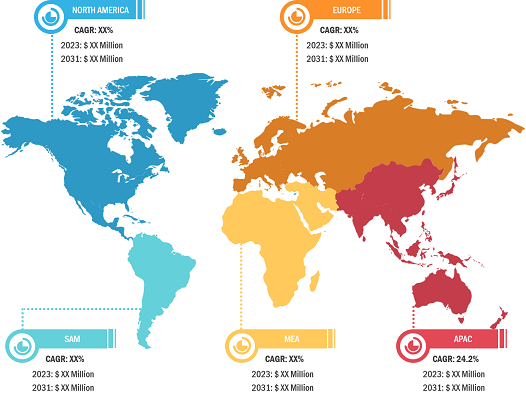Growing Need to Shift from Endpoint Detection and Response to Extended Detection and Response Fuels Extended Detection and Response Market Growth
According to our latest study, “Extended Detection and Response Market Size and Forecast (2021–2031), Global and Regional Share, Trend, and Growth Opportunity Analysis – by Component, Deployment, Enterprise Size, End User, and Geography," the market was valued at US$ 1.62 billion in 2023 and is expected to reach US$ 8.21 billion by 2031; it is estimated to record a CAGR of 22.4% from 2023 to 2031. The report includes growth prospects owing to the current extended detection and response market trends and their foreseeable impact during the forecast period.
Cyberattacks are constantly evolving, leading to the development of new cybersecurity solutions in recent years. One such advancement is endpoint detection and response (EDR), which emerged in the early 2010s to detect and respond to threats on individual endpoints. However, as cyberattacks become more sophisticated, EDR solutions have limited ability to protect entire digital ecosystems. In order to address this issue, there is an increasing need to adopt extended detection and response solutions to include other sources of threat data, such as cloud environments, network traffic, and email systems. XDR Is an extension and evolution of EDR capabilities. The adoption of XDR has gained momentum in recent years as organizations realize the need to extend the range of traditional EDR solutions to deal with increasingly sophisticated threats. XDR is a more comprehensive approach to threat detection and response that provides greater visibility and context into threats by unifying visibility, prioritizing actions, and elevating security productivity via automation and guided response. As the cybersecurity landscape continues to evolve, XDR has become an increasingly important component of organizations' overall security strategies, and key players operating in the market are increasingly advancing EDR solutions to XDR in order to meet this growing demand. For instance, in April 2024, Cybersecurity giant Kaspersky announced the launch of its new flagship product line-Kaspersky Next. Kaspersky Next combines endpoint detection and response (EDR) with extended detection and response (XDR). In July 2021, Sophos combined its EDR and XDR offerings. Intercept X Advanced with EDR became Intercept X Advanced with XDR and Intercept X Advanced for Server with EDR became Intercept X Advanced for Server with XDR. Sophos customers also automatically benefitted from this new offering with no changes in pricing.
Extended Detection and Response Market Analysis — by Geography
Extended Detection and Response Market Size and Forecast (2021 - 2031), Global and Regional Share, Trend, and Growth Opportunity Analysis Report Coverage: By Component (Software and Services), Deployment (Cloud and On-Premises), Enterprise Size (Large Enterprises and SMEs), and End User (IT and Telecom, BFSI, Healthcare, Manufacturing, Retail and E-Commerce, and Others), and Geography
Extended Detection and Response Market Forecast by 2031
Download Free Sample
Source: The Insight Partners Analysis
The security industry is evolving from EDR solutions monitoring the endpoint to XDR solutions monitoring the network, servers, and cloud. Thus, the growing need to shift from EDR to XDR is propelling the extended detection and response market growth.
Broadcom Inc; Palo Alto Networks Inc; SentinelOne Inc; Microsoft Corp; Sophos Ltd.; Cisco Systems Inc; International Business Machines Corp; Check Point Software Technologies Ltd; Fortinet Inc.; and Cybereason Inc are among the key players profiled in the extended detection and response market report. Several other major players were also studied and analyzed during the market study to get a holistic view of the market and its ecosystem.
The report includes the extended detection and response market forecast by component, deployment, enterprise size, and end user. Based on component, the market is categorized into software and services. In terms of revenue, the software segment held a larger extended detection and response market share and is expected to record a higher CAGR during the forecast period.
The scope of the extended detection and response market report focuses on North America (the US, Canada, and Mexico), Europe (Spain, the UK, Germany, France, Italy, and the Rest of Europe), Asia Pacific (South Korea, China, India, Japan, Australia, and the Rest of Asia Pacific), the Middle East & Africa (South Africa, Saudi Arabia, the UAE, and the Rest of Middle East & Africa), and South & Central America (Brazil, Argentina, and the Rest of South & Central America). North America dominated the market in 2023, followed by Europe and APAC.
The Asia Pacific extended detection and response market is segmented into Australia, China, Japan, India, South Korea, and the Rest of APAC. In terms of revenue, China held the largest extended detection and response market share in APAC. The COVID-19 pandemic has accelerated digital adoption and digital service delivery across the world. It also led to the introduction of unconventional work styles into the corporate world. This sudden spike in digital activity has resulted in enormous growth in internet traffic in China, leading to an unprecedented demand for extended detection and response solutions to tackle security risks. Moreover, the rapid adoption of collaboration and network security tools during the pandemic bolstered the use of extended detection and response solutions to ensure protected access to resources. The number and severity of cyberattacks by Chinese cyber criminals have increased in recent years. According to AAG IT Services, the country recorded 14.15 million account breaches from the Q2 to the Q3 of 2022. These stats indicate the significant potential for the growth of the extended detection and response market in China.
Contact Us
Phone: +1-646-491-9876
Email Id: sales@theinsightpartners.com